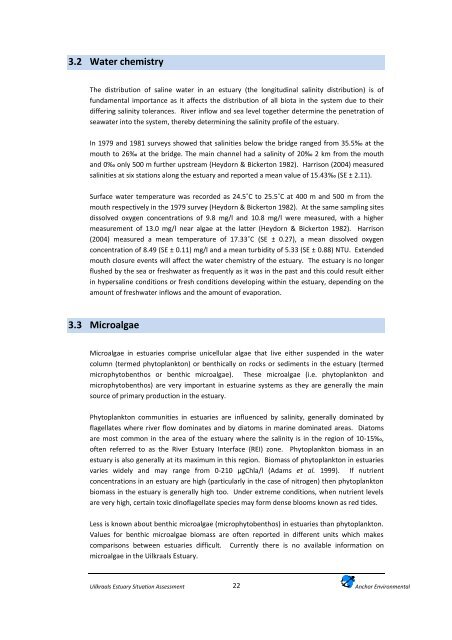Download PDF - Anchor Environmental
Download PDF - Anchor Environmental
Download PDF - Anchor Environmental
Create successful ePaper yourself
Turn your PDF publications into a flip-book with our unique Google optimized e-Paper software.
3.2 Water chemistry<br />
The distribution of saline water in an estuary (the longitudinal salinity distribution) is of<br />
fundamental importance as it affects the distribution of all biota in the system due to their<br />
differing salinity tolerances. River inflow and sea level together determine the penetration of<br />
seawater into the system, thereby determining the salinity profile of the estuary.<br />
In 1979 and 1981 surveys showed that salinities below the bridge ranged from 35.5‰ at the<br />
mouth to 26‰ at the bridge. The main channel had a salinity of 20‰ 2 km from the mouth<br />
and 0‰ only 500 m further upstream (Heydorn & Bickerton 1982). Harrison (2004) measured<br />
salinities at six stations along the estuary and reported a mean value of 15.43‰ (SE ± 2.11).<br />
Surface water temperature was recorded as 24.5˚C to 25.5˚C at 400 m and 500 m from the<br />
mouth respectively in the 1979 survey (Heydorn & Bickerton 1982). At the same sampling sites<br />
dissolved oxygen concentrations of 9.8 mg/l and 10.8 mg/l were measured, with a higher<br />
measurement of 13.0 mg/l near algae at the latter (Heydorn & Bickerton 1982). Harrison<br />
(2004) measured a mean temperature of 17.33˚C (SE ± 0.27), a mean dissolved oxygen<br />
concentration of 8.49 (SE ± 0.11) mg/l and a mean turbidity of 5.33 (SE ± 0.88) NTU. Extended<br />
mouth closure events will affect the water chemistry of the estuary. The estuary is no longer<br />
flushed by the sea or freshwater as frequently as it was in the past and this could result either<br />
in hypersaline conditions or fresh conditions developing within the estuary, depending on the<br />
amount of freshwater inflows and the amount of evaporation.<br />
3.3 Microalgae<br />
Microalgae in estuaries comprise unicellular algae that live either suspended in the water<br />
column (termed phytoplankton) or benthically on rocks or sediments in the estuary (termed<br />
microphytobenthos or benthic microalgae). These microalgae (i.e. phytoplankton and<br />
microphytobenthos) are very important in estuarine systems as they are generally the main<br />
source of primary production in the estuary.<br />
Phytoplankton communities in estuaries are influenced by salinity, generally dominated by<br />
flagellates where river flow dominates and by diatoms in marine dominated areas. Diatoms<br />
are most common in the area of the estuary where the salinity is in the region of 10-15‰,<br />
often referred to as the River Estuary Interface (REI) zone. Phytoplankton biomass in an<br />
estuary is also generally at its maximum in this region. Biomass of phytoplankton in estuaries<br />
varies widely and may range from 0-210 µgChla/l (Adams et al. 1999). If nutrient<br />
concentrations in an estuary are high (particularly in the case of nitrogen) then phytoplankton<br />
biomass in the estuary is generally high too. Under extreme conditions, when nutrient levels<br />
are very high, certain toxic dinoflagellate species may form dense blooms known as red tides.<br />
Less is known about benthic microalgae (microphytobenthos) in estuaries than phytoplankton.<br />
Values for benthic microalgae biomass are often reported in different units which makes<br />
comparisons between estuaries difficult. Currently there is no available information on<br />
microalgae in the Uilkraals Estuary.<br />
Uilkraals Estuary Situation Assessment<br />
22<br />
<strong>Anchor</strong> <strong>Environmental</strong>
















